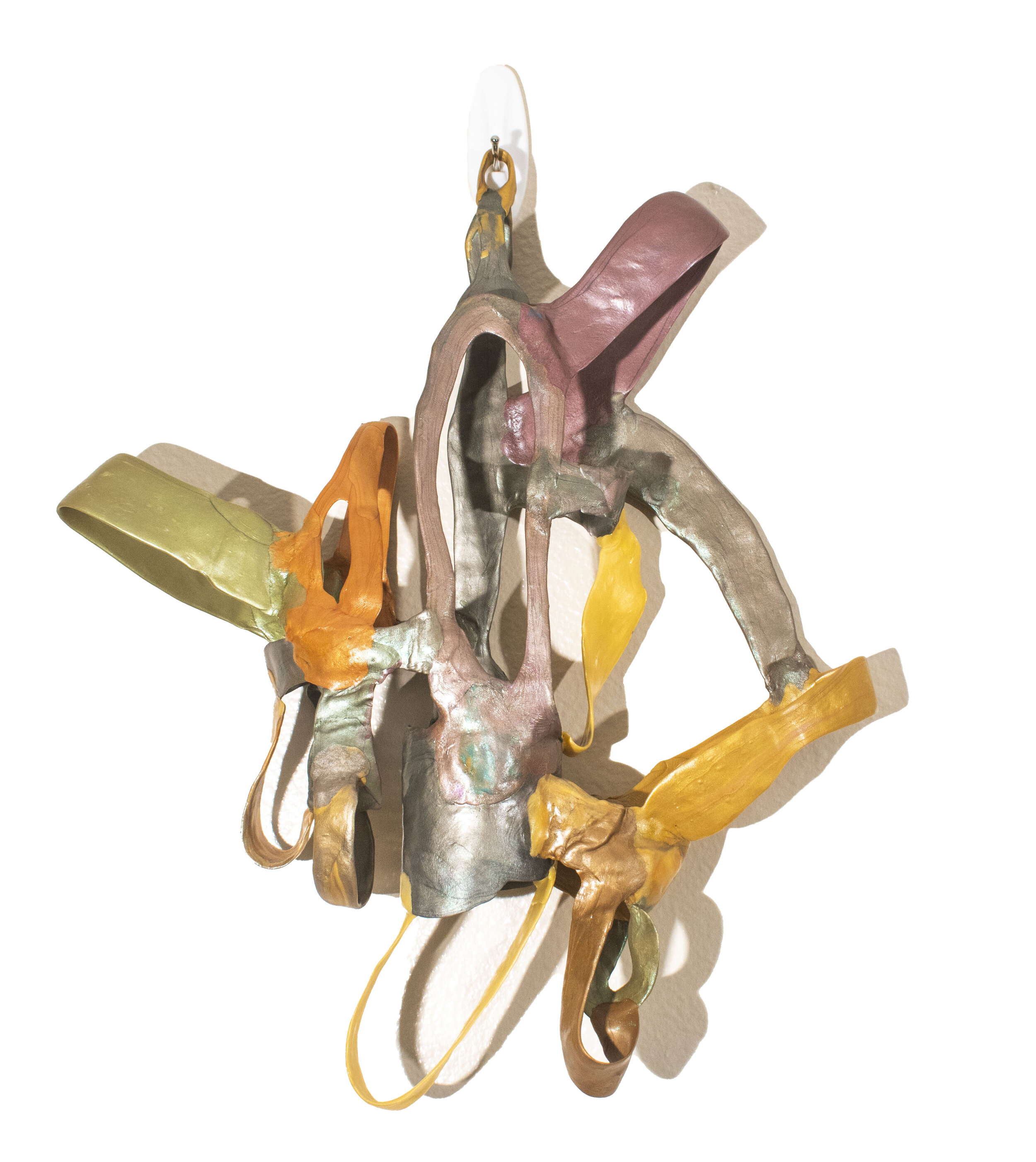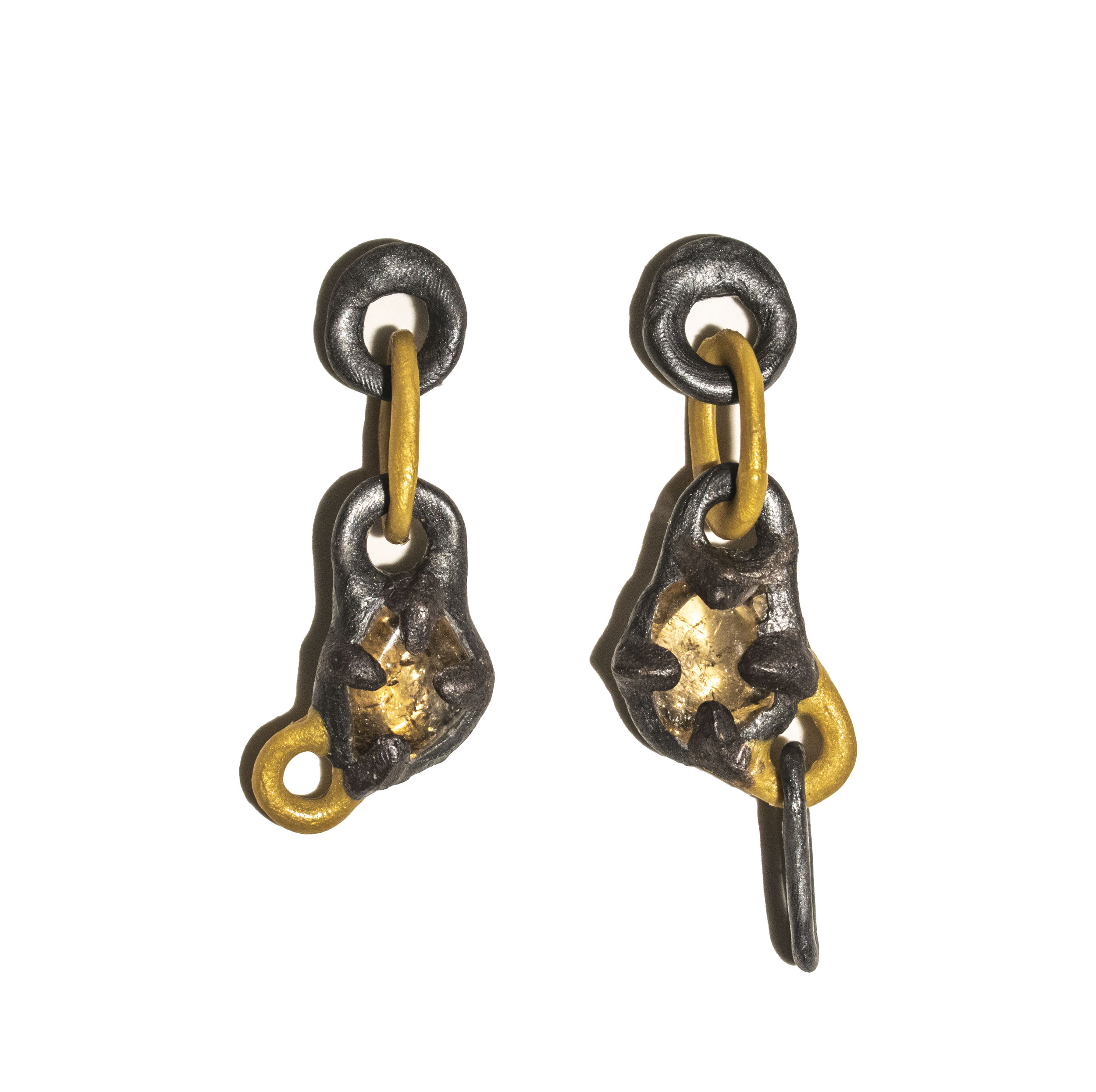S T E V E A L E X I S
Steve Alexis is currently a BFA Metals and Contemporary Art Jewelry candidate at University of Wisconsin-Stout. He is currently interested in creating jewelry and sculpture. His material exploration includes plastic, metal, found and reclaimed objects. His work intends to convey internal contemplation and reflection, with the intention of understanding himself better in the process.
Alexis’ work has been exhibited in numerous shows and galleries both nationally and internationally, including the 2020 micro/MACRO: Intercollegiate traveling exhibition, 2020 Mad for Hoops at Gallery 2052 (IL), and the American Craft Council Show in 2019 (MN). He is represented by Gallery 360 in Minneapolis, MN.
Interview by Ariella Har-Even
Hi Steve! so excited for this opportunity to talk with you about your thesis work and artistic practice. Let’s begin with a little bit about you and the work you make.
Hello, my name is Steve Alexis, I am currently a senior attending the University of Wisconsin-Stout. I am majoring in Studio Art with a concertation in Metals and Contemporary Art Jewelry. I’m also make paintings, sculpture, and recently ceramic vessels.
In your artist statement you write, “I am driven to act by materials, their exploration is a conduit to my work process.” I am wondering how experimentation and exploration play into your process with materials depending on their predictability? When you’re working with thermoplastics, for instance, I imagine the ability to control it is lesser so than with metal.
That’s a fair assumption to make. For me however, having as much direct physical contact with material is where exploration truly lives and breathes. That is not to say that using tools is somehow a limiting factor in the making process. I regularly use sponges, brushes, tongs, dental picks and tweezers for all forms of the work I make. I have yet to escape the propensity to use my hands directly in my work. I lean heavily on intuitive thought/actions and “just do it with yours hands” is an impulse that has always felt like the correct move to make. With repetition and an open ear to what the materials are telling you in response to your input, you’re able to have more confidence in work outcomes.
Can you talk a little about repeated action and response? You call it engaging in “dialogue with the material”. How does repetition change this dialogue over time, as it builds your skill set and comfort level?
There is a great impulse for me to feel the materials in my hands. I believe this experience to be more than just physical stimulation. Much in the same way I am touching the material, the material is also touching and recording the interaction. The way in which material reacts to my input is the same as the response given in a verbal conversation. For better or worse I rarely write down anything about material exploration, because the majority of the learning is done in the moment. Is the plastic hot enough for me to mold it this way? How much pressure is needed to form this shape? How long should I wait until its ready to handle again? Such questions are answered quite promptly in the materials reaction. It’s my job to ask the right questions and be attentive in listening to the answers. It’s just like having a partner, you’ll only really learn about them the longer you spend with them and with real effort. Over time you’re able to connect with them on a deeper level with what you’ve learned, but there’s always just a bit more to discover. I’ve recently begun making vessels out of terracotta and I’ve found that the experience I accumulated working with thermoplastics has allowed me to be more receptive to what the clay is trying to tell me.
Speaking of dialogue, tell us about the interaction between your pieces and their placement on the body. What is it about jewelry that allows you to delve deeper into conversations about abstraction, emotion, and instinct?
The interaction between the body and art is a special experience that I believe only jewelry can truly portray. There is a fair amount of commitment required to wear jewelry. To be able wear certain forms of jewelry you need to pierce a hole in your body and keep the wound from closing. The display of jewelry is also the commitment in knowing you’re revealing more about yourself than you are adorning. People use physical appearance to glean insight and make assumptions about those around them. What you wear and how you appear become who you are. In this sense, adornment is not merely the accentuation or embellishment of your physical form, there is union between body and jewelry in the form of an “adorned person”. The work forms I create are vessels to convey my sentiment in physical form. I believe the intimacy involved in wearing and joining these forms to one’s body allows for my intent to speak in ways I couldn’t otherwise. In this way, the wearer also exists as the artwork.
How do you think your time at UW Stout has influenced the work you make?
I originally came to Stout to major in Mechanical Engineering. In hindsight there were slight signs of interest, but art was not on the forefront of my mind. I sort of fell into art and jewelry making after taking my first Art Metals class. From that point I slowly realized my passion for making art. I was lucky enough to have knowledgeable professors who challenged me to continuously make better work. I’m not sure how long it would have taken me to become an artist, or if I would have ever discovered art had I not happened to attend Stout.
You prefer to identify as an artist or maker, avoiding the label of jeweler. Do you find this is due to your interest in making work that is not for the body, or rather a desire not to comply with society’s definitions of jewelry and wearable art?
I think labels like Jeweler, Ceramicist, or Sculptor speak to a significant level of dedication to that field. At least that’s what the label says to me. “I am a Jeweler; my time is dedicated to making jewelry. I’ve always been a greedy person. The more time I’ve spent making jewelry, I found myself wanting to paint more, then make sculpture, and now ceramics. The common thread is the desire to make, causing me to constantly bounce between each discipline. The desire I have for making leads me to continue to make jewelry and whatever else draws my interest.
Can you speak about the way you use color, pattern, and texture to convey the subconscious? I’m interested in how this connects to conceptual exploration, and to your choice to leave evidence of the process such as fingerprints and tool marks in the final pieces.
My current practice revolves around the exploration of materials and the influence of the subconscious. The decisions made about color, form, and pattern are dictated from outside the conscious mind’s purview. As such, the jewelry forms are records of the exploration of material and unconscious mind. The voice of intuition causes the action and the material responds. It is through that cycle that my work is created. Since the exploration process is so important to make practice choosing the materials the highlight the evidence of that dialogue is important. The physical appearance of the forms is a product of subconscious mind and material response meeting together in the middle.
Can you share anything about your plans for post-graduation? Is there anything you would have liked to explore while in school but didn’t have time to?
I think the plan for now is to find a grad-school that allows my practice to progress further. I am however open to whatever opportunities get me closer to a future as a professional artist.
Finally, any pearls of wisdom for students currently working on their thesis?
You’ve learned enough from those around you, it’s now time to fully take reigns and trust your intuition. That doesn’t mean you can’t still ask for opinions or get clarification on something, but it is your show at the end of the day, and it will be what you make of it. No matter how important it may or may not seem to you, it is a milestone nonetheless and you should make work that you’ll be proud to look back on.







